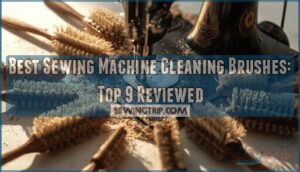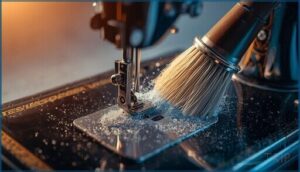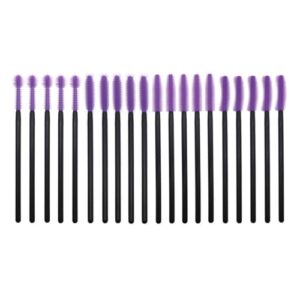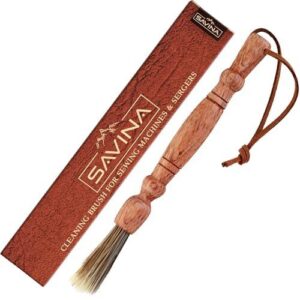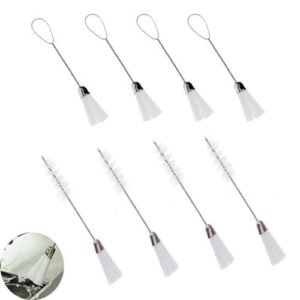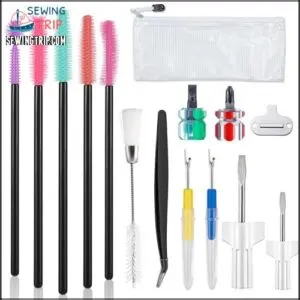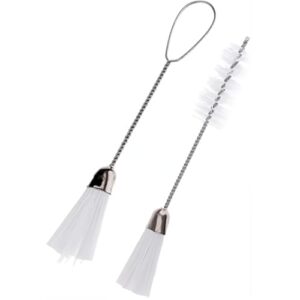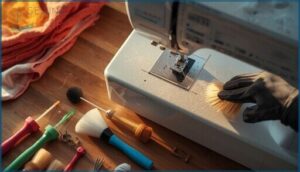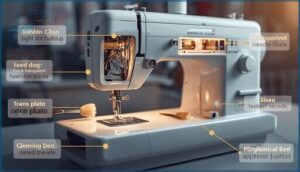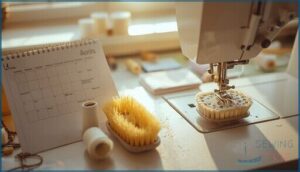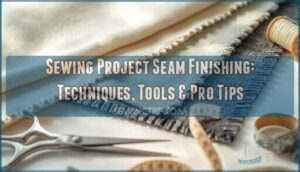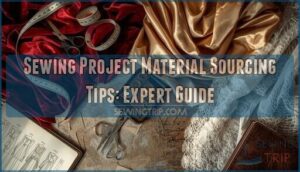This site is supported by our readers. We may earn a commission, at no cost to you, if you purchase through links.
Your sewing machine runs smooth until it doesn’t. Skipped stitches appear. Thread breaks without warning. The machine sounds different. Most sewers reach for oil or check the needle. But the real culprit often hides in plain sight: lint packed into feed dogs and bobbin cases.
A single project can leave behind enough debris to affect tension and timing. The right sewing machine cleaning brush removes this buildup before it causes problems. Different bristle types tackle different surfaces. Metal bristles scrape stubborn debris while soft horsehair protects delicate components.
The tools you choose determine how well you can reach tight spaces and maintain consistent machine performance.
Table Of Contents
- Key Takeaways
- Essential Features of Sewing Machine Cleaning Brushes
- Benefits of Using a Sewing Machine Cleaning Brush
- Top 9 Sewing Machine Cleaning Brushes Reviewed
- 1. Sewing Machine Cleaning Brush Set Purple
- 2. Singer Angled Edge Sewing Lint Brush
- 3. Savina Sewing Machine Cleaning Brush
- 4. Sewing Machine Cleaning Brush Set
- 5. Sewing Machine Cleaning Brush Set Silicone
- 6. Savina Sewing Machine Cleaning Brush Set
- 7. Sewing Machine Cleaning and Repair Kit
- 8. Double Ended Sewing Machine Cleaning Brush
- 9. FJW Sewing Machine Cleaning Brush Set
- How to Choose The Right Cleaning Brush
- Proper Cleaning Techniques for Sewing Machines
- Frequently Asked Questions (FAQs)
- Conclusion
Key Takeaways
- Your sewing machine needs regular cleaning with the right brush because lint buildup in feed dogs and bobbin cases causes skipped stitches, thread breaks, and timing problems before you notice.
- Nylon bristles work best for most cleaning jobs since they remove debris without scratching, while bendable designs and angled heads let you reach tight spaces around the hook race and needle plate.
- Clean your bobbin area every 2-3 bobbin changes or after each project when using high-lint fabrics like fleece, and schedule professional servicing once a year to catch what brushes can’t reach.
- A quality cleaning brush costs $3-7 and prevents expensive repairs by extending your machine’s lifespan from a few years to 10-25 years when you maintain it consistently.
Essential Features of Sewing Machine Cleaning Brushes
Not all cleaning brushes work the same way for sewing machines. The right one makes the difference between a quick cleanup and actually getting into those tight spaces where lint hides.
Let’s look at what features matter most when you’re choosing a brush that’ll keep your machine running smoothly.
Brush Materials and Bristle Types
Your sewing machine cleaning brush choice starts with bristles. Most brushes use nylon bristles because they bounce back after bending and resist oils from your machine. Some softer options feature horsehair bristles for delicate surfaces. Want extra protection? Antistatic brushes prevent static buildup near electronics. Metal bristles exist for heavy-duty work, though they’re overkill for routine maintenance. For example, a horsehair dusting brush is available online.
- Nylon bristles: Durable and bounce back after each use
- Horsehair bristles: Soft touch on painted or delicate parts
- Antistatic brushes: Safe for computerized machines
- Metal bristles: Heavy-duty option for stubborn debris
Bendability and Precision Cleaning
Bendability transforms how you reach into your machine’s tight mechanisms. Flexible shafts let you navigate around the hook race and under the needle plate without forcing rigid tools into delicate areas. Angled heads position bristles parallel to internal surfaces, protecting components while removing lint. Regular cleaning prevents sewing machine malfunction. This precision approach prevents scratching tension assemblies and sensor points. A micro tip design gives you control in confined spaces where larger tools can’t reach safely.
| Feature | Benefit | Best For |
|---|---|---|
| Flexible Shaft | Reaches tight angles | Bobbin cases |
| Angled Head | Protects components | Hook assembly |
| Micro Tip | Precision control | Feed dog gaps |
Size and Shape for Tight Spaces
Now that you understand how bendability works, let’s talk dimensions. The right brush head diameter makes all the difference—16 to 30 mm sizes fit snugly into tight spaces without forcing. Handle length ranges from 127 mm for close control around your presser foot to 210 mm when you need reach into deeper cavities.
Bristle profile matters too. Narrow, tapered designs slip under your needle plate and into bobbin cases where bulky heads can’t go. Specialized shapes access crevices that standard brushes miss entirely.
Color Variety and Design Options
Beyond dimensions and materials, color has a practical purpose. Most multicolor packs come in yellow, pink, and blue—each color designated for different machine areas to prevent lint cross-contamination.
This color-coded system helps you quickly identify which brush goes where. The bright grips contrast sharply against your machine’s metal interior, making tools easier to spot during maintenance.
It’s not just aesthetic coordination; it’s functional organization that keeps your cleaning routine efficient and your workspace visually cohesive.
Benefits of Using a Sewing Machine Cleaning Brush
A clean sewing machine runs better and lasts longer. Regular cleaning stops lint and dust from building up inside, where they cause problems.
Here’s what you’ll gain by keeping your machine clean.
Improved Machine Performance
When your machine runs sluggish or produces skipped stitches, lint and debris are usually the culprit. Regular cleaning with precision brushes restores stitch consistency and maintains sewing speed by keeping your bobbin area, feed dogs, and tension discs clear.
Better thread handling follows naturally when these components stay clean. You’ll notice smoother operation, fewer jams, and reliable performance across different fabrics. Sewing Machine Cleaning Brushes make Machine Cleaning simple and effective.
Prevention of Lint and Debris Buildup
Lint buildup happens fast, especially with high-shedding fabrics like fleece and brushed cotton. Low-quality thread makes it worse. That’s where sewing machine cleaning brushes shine. Their fine bristles grab lint from tight spots—under the needle plate, around the bobbin case, in feed dogs—before debris compacts into stubborn clumps.
Regular cleaning after each project prevents lint from migrating into tension disks and moving parts, stopping skipped stitches and thread breaks before they start.
Enhanced Longevity of Sewing Machines
When you skip cleaning, your machine ages fast. Regular sewing machine cleaning with brushes directly extends your baseline lifespan from just a few years to 10-25 years or more. Mechanical wear accelerates when lint and debris stay trapped in moving parts, causing friction that damages gears and bearings. Consistent cleaning frequency—every few bobbins or monthly—prevents this damage and keeps everything running smoothly.
Regular cleaning with brushes extends your sewing machine’s lifespan from a few years to 10-25 years by preventing lint-driven friction that damages internal gears and bearings
- Prevents premature failure of feed mechanisms and hook assemblies
- Reduces friction that ages internal components faster
- Keeps machines reliable through decades of use
- Maintains peak performance and consistent stitch quality
Cost Savings on Repairs and Maintenance
Your wallet breathes easier when you clean regularly. A thorough Sewing Machine Cleaning routine with brushes slashes annual service frequency from $100 visits to once every two years, while Repair Avoidance prevents $100-$300 motor replacements caused by lint-driven overheating. Downtime Reduction keeps projects on schedule, and Energy Efficiency gains of 5-10% lower your power bills. Extended Lifespan means you’ll postpone that $500+ replacement for years.
| Cost Category | Without Brushes | With Regular Sewing Machine Cleaning Brushes |
|---|---|---|
| Annual Service | $100/year | $50/year (extended intervals) |
| Repair Events | $100-$300 each | Avoided through Machine Maintenance |
| Machine Lifespan | 3-5 years | 10-25+ years with Sewing Machine Maintenance |
Top 9 Sewing Machine Cleaning Brushes Reviewed
Now that you know why a good cleaning brush matters, let’s look at your options.
We’ve tested and reviewed nine different brushes to help you find the right one for your machine. Each option has specific features that make it useful for different cleaning needs.
1. Sewing Machine Cleaning Brush Set Purple
You’ll find the 20-piece Purple Nylon Bristle Set offers great versatility for Sewing Machine Maintenance. The dense nylon Bristle Material excels at dislodging lint and dust while remaining gentle on delicate parts.
This kit provides varied Cleaning Tools in multiple sizes to reach every corner of your machine. Bendability Benefits shine when you need Tight Space Cleaning around bobbin cases and feed dogs.
The purple Color Aesthetics make these brushes easy to spot in your workspace. Kit Versatility extends beyond standard Sewing Machine Cleaning—you can use these Cleaning Brushes on sergers and other equipment without worry.
Best For: Quilters and sewing enthusiasts who clean their machines frequently and need versatile tools to reach tight spots around bobbin cases, feed dogs, and other hard-to-access areas.
- 20 reusable pieces in multiple sizes and shapes let you tackle different cleaning tasks and reach every corner of your machine
- Dense nylon bristles effectively remove lint and dust without scratching delicate metal or plastic parts
- Easy to clean with soapy water and lightweight enough (1.76 oz) to handle comfortably during detailed work
- Some users find the brushes too bendy or flimsy for heavier cleaning tasks
- May not work as well as expected compared to traditional methods like Q-tips and oil
- Build quality and stiffness receive mixed feedback from customers
2. Singer Angled Edge Sewing Lint Brush
The Singer S02056 gives you remarkable control with its rubber-grip handle and angled edge design. This white nylon brush weighs just 0.48 ounces yet delivers serious precision cleaning power.
Handle ergonomics matter when you’re reaching tight bobbin areas. The angled bristles target hard-to-reach spots where standard brushes fail.
You’ll appreciate its machine compatibility across Singer models and other brands. At roughly 6 inches long, it’s sized perfectly for sewing machine maintenance without excess bulk.
The bristle material removes lint without scratching delicate components. Some users report durability concerns with handle separation.
Best For: Home sewists who need to clean tight bobbin areas and feed dog spaces in their sewing machines without scratching delicate metal surfaces.
- Angled bristle design reaches narrow spaces under needle plates and around bobbin cases that straight brushes can’t access
- Rubber-grip handle gives you solid control when cleaning small components and hard-to-reach areas
- Lightweight at 0.48 ounces and budget-friendly, making it easy to use for regular maintenance without hand fatigue
- Some users report the brush head separates from the handle during use, raising durability concerns
- Bristles may shed or fall out over time according to customer feedback
- Size expectations vary—some find it larger than anticipated while others think it’s just right
3. Savina Sewing Machine Cleaning Brush
The Savina Sewing Machine Cleaning Brush combines hardwood construction with high-density nylon bristles that resist deformation during regular use. At 4.92 inches total length with 1.38-inch bristles, this single-ended brush reaches bobbin cases and feed dogs without excess bulk.
You’ll find the smooth wood handle comfortable during weekly maintenance sessions. The nylon bristle density delivers solid cleaning performance on lint-prone areas without scratching metal components.
Priced between $3 and $7, it’s positioned as a moderate-option sewing machine cleaning tool that works across both domestic and industrial machines.
Best For: Sewers and quilters who need an affordable, compact brush to clear lint from bobbin cases and feed dogs during routine weekly or monthly maintenance sessions.
- High-density nylon bristles hold their shape through repeated cleaning cycles and won’t scratch metal or plastic machine parts
- Compact 4.92-inch design with 1.38-inch bristles fits into tight bobbin and needle-plate areas where larger brushes can’t reach
- Affordable price point between $3 and $7 makes it an accessible preventive-maintenance tool that costs less than a single professional servicing
- Some users report the brush feels too large for ultra-compact machine compartments
- Dust and lint fibers can cling to the nylon bristles, requiring you to clean the brush itself between uses
- Limited long-term durability information means you may not know how many cleaning cycles to expect before bristles wear down
4. Sewing Machine Cleaning Brush Set
This Sewing Machine Cleaning Brush Set delivers eight metal and nylon tools in a bundled servicing package that covers most lint removal needs. The set composition includes both single-ended (6.49 inches) and double-ended designs (6.88 inches) with bristle heat-resistance rated to 80–100°C. You get a Singer-style brush alongside multiple nylon heads for targeting bobbin cases and feed dogs.
User ratings consistently hit 4.5 out of 5 stars. The dual-ended configuration helps with sewing machine maintenance across keyboards and bottle crevices too. It’s a practical multi-tool approach to cleaning brushes.
Best For: Hobbyists and home sewers who work with high-lint fabrics like fleece or flannel and need affordable tools to keep their bobbin area and feed dogs clean between projects.
- Eight-piece set covers different cleaning needs with single and double-ended brushes, plus the classic Singer-style design fits tight bobbin and feed dog spaces
- Heat-resistant nylon bristles (up to 100°C) won’t melt near warm motors, and the soft heads are safe for plastic parts
- Strong user ratings above 4.5 stars show these brushes actually work for routine lint removal and multi-use cleaning around the house
- Won’t handle heavy or caked-on debris—you’ll need deeper tools or compressed air for stubborn buildup
- Requires occasional rinsing to stay effective, and storing eight small brushes means you might lose a few over time
- Not ideal for extremely delicate surfaces, so test carefully on vintage machines or sensitive finishes before scrubbing
5. Sewing Machine Cleaning Brush Set Silicone
A 20-piece Silicone Bristle Properties kit shifts your maintenance routine toward reusable tools. These dense flexible heads won’t scratch metal surfaces and wash clean in mild soapy water for repeated use.
Cleaning Performance stands out around bobbin cases where silicone captures lint without pushing debris deeper like canned air does. The Rose Red plastic grips measure 4.13 inches and weigh just 1.13 ounces total.
Cross-Application Usage extends beyond Sewing Machine Cleaning to keyboards and bottle necks. Reusability Hygiene means you air-dry the bristles between sessions instead of tossing disposables.
Best For: Home sewers and quilters who need to clean tight bobbin areas frequently and want washable tools that won’t scratch delicate machine parts.
- Dense silicone bristles lift lint from bobbin cases and feed dogs without pushing debris deeper into the mechanism like canned air does
- Washable and reusable design lets you clean the brushes with mild soap and air-dry them instead of constantly buying disposables
- 20-piece set gives you multiple brush heads for different machine corners, plus extras to use while others dry
- Some users report the brushes feel flimsy and don’t hold up well over time with repeated use
- Mixed feedback on how effectively the bristles actually grab and remove stubborn lint compared to expectations
- May struggle to clean off oily residue or dirt that’s stuck on, requiring additional cleaning methods
6. Savina Sewing Machine Cleaning Brush Set
While silicone kits offer reusability, wood and nylon bring durability you can feel. This 7.24-inch Savina brush weighs 1.13 ounces and features dense nylon bristles on smooth hardwood. The Ergonomic Design includes a hanging strap so you store it near your workspace.
Set Configuration delivers a single-ended tool that navigates bobbin areas and feed dogs in domestic or industrial machines. Bristle Composition resists shedding during repeated lint removal.
Market Position places it as a mid-range option around four to five dollars, ideal for sewers wanting reliable Machine Cleaning without frequent replacement.
Best For: Home sewers and quilters who want a reliable, single-ended brush that reaches tight spots in domestic or industrial machines without breaking the bank.
- Dense nylon bristles resist shedding even after lots of use, so you’re not cleaning up the cleaner
- Hardwood handle with a hanging strap makes storage easy and keeps the brush right where you need it
- At around four to five dollars, it’s a solid middle ground between cheap disposables and pricey multi-tool kits
- Some users say the 7.24-inch length feels too big for compact machine spaces
- Lint and thread fibers tend to cling to the bristles, requiring you to clean the brush itself
- Single-ended design means you only get one bristle profile, unlike double-ended options that give you more versatility
7. Sewing Machine Cleaning and Repair Kit
When your machine needs more than lint removal, an extensive toolkit changes everything. The 15-piece Groodo kit combines Kit Components like tweezers, rippers, screwdrivers, and dual-head brushes in one storage bag.
Tool Durability varies—some users note flimsy tweezers—yet the variety aids both Sewing Machine Cleaning and minor Sewing Machine Repair tasks.
Cost Savings become clear when you consider professional service runs $100 to $150 per visit. Regular Maintenance Functions with these Sewing Machine Accessories promote Longevity Outcomes by keeping your Machine Cleaning and Repair routine simple and affordable.
Best For: Sewers who want to handle routine machine maintenance at home and avoid paying $100+ for professional cleaning services.
- Comprehensive 15-piece set covers everything from lint removal to minor adjustments, with multiple screwdrivers and brushes for different machine areas
- Comes with a storage bag that keeps all your tools organized and easy to grab when maintenance time rolls around
- Costs a fraction of one professional service visit while letting you clean your machine as often as needed
- Tweezers can be flimsy and bend easily when you’re trying to pull out stubborn threads or debris
- Brushes may flex under pressure instead of staying rigid, making it harder to scrub tough spots
- Quality varies across the tools—some pieces work great while others feel less durable than you’d hope
8. Double Ended Sewing Machine Cleaning Brush
When two brush heads share one handle, you gain flexibility for every corner of your machine. The KUJOBUY Double Ended Sewing Machine Cleaning Brush features white plastic construction with one fine tip and one broader head—ideal for bobbin cases and feed dogs.
This Ergonomic Design fits comfortably in your hand during Sewing Machine Maintenance sessions. Bristle Material is nylon, ensuring non-abrasive Cleaning Performance.
However, Brush Longevity concerns arise—users report bristles pulling out and the metal core bending. Maintenance Frequency depends on fabric type, but these Cleaning Brushes handle routine Sewing Machine Cleaning when replacement becomes necessary.
Best For: Sewers and quilters who need an affordable tool to reach tight spots like bobbin cases and feed dogs during regular machine maintenance.
- Double-ended design gives you a fine tip for delicate areas and a broader brush for larger surfaces, so one tool handles multiple cleaning jobs.
- Nylon bristles won’t scratch metal or plastic parts, making it safe for routine use on tension disks and needle plates.
- Low price point means you can keep extras on hand and replace them as needed without worrying about the cost.
- Bristles tend to pull out or fall off with regular use, so durability is a real issue.
- The metal core can bend easily, which limits how much pressure you can apply in stubborn lint zones.
- Bristles may absorb oil and discolor over time, affecting both appearance and cleaning effectiveness.
9. FJW Sewing Machine Cleaning Brush Set
Twenty precision tools in one set give you extensive reach across your entire machine. The FJW Sewing Machine Cleaning Brush Set features Silicone Bristle Design with dense packing for excellent Cleaning Performance in bobbin areas and feed dogs. Each brush measures 4.13 inches—perfect for tight motor ports and oiling holes during Sewing Machine Maintenance.
Reuse and Hygiene stand out because you rinse these Sewing Machine Cleaning tools with water between sessions. Cost Implications favor bulk purchase, while Usage Scenarios extend beyond Sewing Machine Accessories to keyboards and electronics, maximizing value across multiple Cleaning Brushes applications.
Best For: Home sewers and hobbyists who need affordable, reusable tools to clean tight spaces in sewing machines, keyboards, and small electronics.
- Twenty silicone brushes give you dedicated tools for different areas—oil zones, lint traps, and dry compartments—without cross-contamination.
- Rinse and reuse design cuts down on waste and saves money compared to tossing disposable cotton swabs after every cleaning session.
- Four-inch length reaches deep into bobbin cases, motor ports, and oiling holes without needing to disassemble your entire machine.
- Some users report the brushes feel flimsy and less durable than expected, especially with repeated use.
- Silicone bristles don’t always grab stubborn lint as effectively as stiffer nylon options, leaving some debris behind.
- Not designed for oily or greasy buildup—you’ll need separate tools or solvents for those tougher cleaning jobs.
How to Choose The Right Cleaning Brush
Picking the right cleaning brush isn’t just about grabbing the first one you see. You need to think about what kind of machine you have and how often you sew.
Let’s look at the key factors that will help you choose a brush that actually works for your needs.
Factors to Consider Before Buying
Bristle material tops the list when you’re shopping for cleaning brushes. Nylon resists fraying and won’t scratch delicate parts, while low-quality options shed fibers that defeat the whole purpose.
Here’s what else matters:
- Brush size and shape – Narrow heads fit under needle plates and reach feed dogs in tight millimeter-wide spaces.
- Machine compatibility – Check your manual; some models prohibit abrasive tools.
- Build quality – Firm bristles remove compacted lint without breaking during repeated use.
Comparing Single Vs. Multi-Pack Options
You’ll pay $1 to $3 for single premium cleaning brushes with metallic grips, but multi-pack sets drop the cost per brush to thirty cents when you buy twenty-five at once.
Storage and access improve when you can place cleaning tools at each machine or workstation. If you clean after every project or run multiple machines, a 25-pack suits your usage frequency better than replacing one tool repeatedly.
Dual-Ended and Specialty Designs
Dual-ended brushes give you a flat lint sweeper on one side and a narrow pick tip on the other, letting you tackle wide surfaces and tight bobbin channels with one tool. Angled heads reach around corners without taking apart machine covers.
Multi-piece sets assign each brush to a specific zone—one for feed dogs, another for tension disks—so you clean faster and avoid cross-contaminating oil and lint.
Price and Value Considerations
Single brushes run $3 to $7, but multipacks drop your per-brush cost to pennies—smart if you maintain several machines. Double-ended tools add versatility without doubling the price.
Brand names like Singer command a modest premium, yet generic brushes clean just as well. Investing $10 in a maintenance kit beats a $50 repair bill.
Compare sale prices across retailers and weigh feature value against your actual cleaning needs.
Proper Cleaning Techniques for Sewing Machines
Knowing how to use your cleaning brush correctly makes all the difference in keeping your machine running smoothly. The right technique helps you reach problem areas without causing damage or missing hidden lint.
Let’s walk through the essential steps and practices that will keep your sewing machine in top condition.
Step-by-Step Cleaning Process
Before you begin machine disassembly, turn off and unplug your machine to guarantee safety. Follow these cleaning steps:
- Remove the needle, presser foot, and thread for clear access
- Take out the bobbin case and lift the needle plate
- Brush lint from feed dogs and hook areas using gentle outward strokes
- Wipe upper thread paths and replace components
Run a post-clean test on scrap fabric to confirm smooth operation.
Areas to Target With Cleaning Brushes
Your brush needs to reach five critical zones. Start with the bobbin case and hook race where lint packs tightest. Next, sweep between each feed dog tooth under the needle plate.
Open the face plate to brush tension discs and the upper thread path. Finally, clean around the needle bar and wipe the machine bed near access openings.
Maintenance Frequency Recommendations
Once you know where to clean, you need to know when. Fabric type drives your schedule—fleece and minky demand lint removal after each project. For standard cottons, brush the bobbin area every 2–3 bobbin changes or roughly 8 hours of sewing time.
Usage intensity matters too: daily sewers should clean weekly, while occasional users can stretch to monthly.
Storage conditions and environment factors also count. Dusty rooms require more frequent dust removal. Schedule professional servicing annually to catch what your brush can’t reach, keeping your machine maintenance routine complete.
Safety Tips When Cleaning Your Machine
Before you start sewing machine cleaning, power disconnection is your first line of defense. Unplug the cord to prevent accidental motor activation and electric shock.
Follow these product warnings for safe machine maintenance:
- Remove the needle to avoid puncture injuries during cleaning
- Skip compressed air and hazardous materials that force lint deeper into mechanisms
- Wear protective equipment like safety glasses to shield against flying debris
Keep cleaning supplies away from hot components to support fire prevention.
Frequently Asked Questions (FAQs)
Can I make a homemade cleaning brush alternative?
Yes. You can use trimmed paintbrushes, mascara wands, or pipe cleaners inserted through straws for routine lint removal. Choose synthetic bristles that won’t shed. Avoid loose fibers that could jam sewing machine parts.
Are all cleaning brushes compatible with every machine?
Not every brush works on all machines. Model compatibility varies because machine layouts differ. Check your manual first.
Bristle shedding and size limitations can cause damage risks.
Material safety matters for sewing machine parts and proper machine cleaning maintenance.
How do I clean the brush itself?
Your brush deserves as much care as your machine. Soak it in hot soapy water for ten minutes. Rinse thoroughly and air-dry completely.
This simple cleaning routine maintains bristle integrity and ensures effective machine care.
What other tools complement sewing machine cleaning brushes?
Tweezers and needle‑nose pliers handle precision removal of trapped threads. Mini screwdrivers provide access to needle plates. Micro vacuum accessories clear heavy lint, while cotton swabs reach tiny crevices. Oil bottles complete sewing machine maintenance after debris removal.
Do computerized machines require different cleaning approaches?
Like a high-performance engine versus a simple motor, computerized machines demand gentler care. Electronic sensitivity restricts compressed air and metal tools near circuits. Cleaning frequency increases around sensors.
Professional sewing machine maintenance protects delicate threading systems from dust-related risk management failures.
Conclusion
An ounce of prevention beats a pound of cure for machine care. The right sewing machine cleaning brush keeps your equipment running without expensive repairs.
Pick tools that reach your machine’s tight spaces. Match bristle types to your cleaning needs. Set a regular maintenance schedule.
Your machine will reward consistent care with smooth stitches and reliable performance. Clean equipment means fewer interruptions and more time creating the projects you love.
- https://www.wawak.com/sewing/sewing-machine-parts-accessories/sewing-machine-accessories/nylon-dual-bristle-machine-cleaning-brush-6/
- https://www.youtube.com/watch?v=0TnydB83w28
- https://www.sewingpartsonline.com/blogs/education/sewing-machine-maintenance-updated
- https://www.reddit.com/r/quilting/comments/1cnasvd/favorite_tools_for_cleaning_your_sewing_machine/
- https://sewersclub.com/blogs/sewing-and-instructional/sewing-machine-maintenance-101-keeping-your-machine-in-top-shape

